Analyzing Disability Support Models and Rights in Australian Context
VerifiedAdded on 2023/06/18
|6
|2159
|143
Homework Assignment
AI Summary
This assignment provides a comprehensive analysis of disability support models in Australia, contrasting the social and medical models, and the institutionalized versus person-centered approaches. It explores practical support strategies for individuals with various disabilities, including Autism Spectrum Disorder, cognitive and physical disabilities, and sensory impairments. Furthermore, it addresses the importance of understanding and upholding the rights of individuals with disabilities, particularly focusing on how Julie can assist clients like Ji-yoon, Emma, and Peter in understanding their rights and cultural needs. The assignment also examines the indicators of possible abuse and neglect, outlining the steps Julie should take if abuse is suspected, and referencing relevant Australian laws pertaining to the abuse of persons with disabilities. This resource is available on Desklib, a platform offering a wide range of study tools and solved assignments for students.
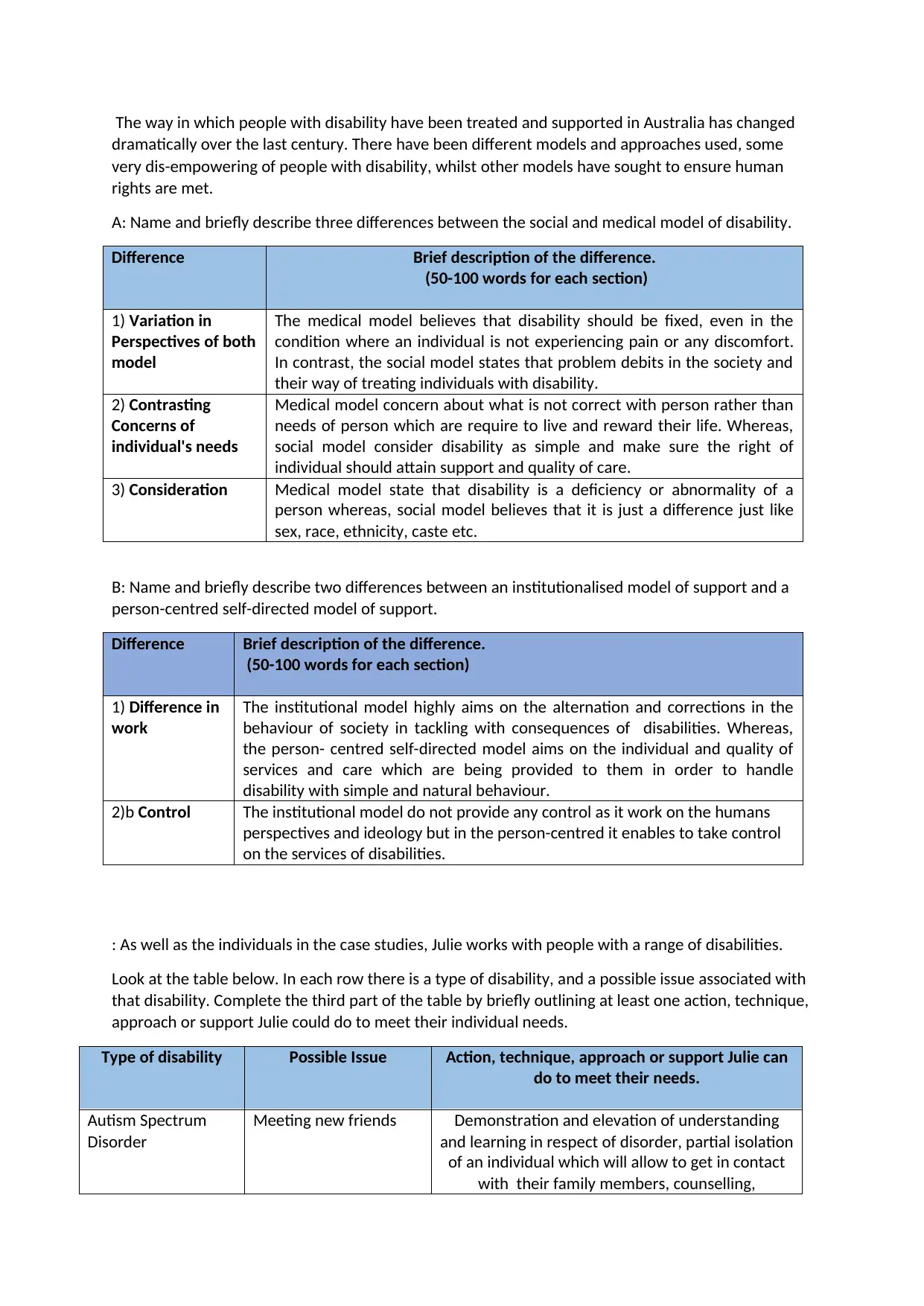
The way in which people with disability have been treated and supported in Australia has changed
dramatically over the last century. There have been different models and approaches used, some
very dis-empowering of people with disability, whilst other models have sought to ensure human
rights are met.
A: Name and briefly describe three differences between the social and medical model of disability.
Difference Brief description of the difference.
(50-100 words for each section)
1) Variation in
Perspectives of both
model
The medical model believes that disability should be fixed, even in the
condition where an individual is not experiencing pain or any discomfort.
In contrast, the social model states that problem debits in the society and
their way of treating individuals with disability.
2) Contrasting
Concerns of
individual's needs
Medical model concern about what is not correct with person rather than
needs of person which are require to live and reward their life. Whereas,
social model consider disability as simple and make sure the right of
individual should attain support and quality of care.
3) Consideration Medical model state that disability is a deficiency or abnormality of a
person whereas, social model believes that it is just a difference just like
sex, race, ethnicity, caste etc.
B: Name and briefly describe two differences between an institutionalised model of support and a
person-centred self-directed model of support.
Difference Brief description of the difference.
(50-100 words for each section)
1) Difference in
work
The institutional model highly aims on the alternation and corrections in the
behaviour of society in tackling with consequences of disabilities. Whereas,
the person- centred self-directed model aims on the individual and quality of
services and care which are being provided to them in order to handle
disability with simple and natural behaviour.
2)b Control The institutional model do not provide any control as it work on the humans
perspectives and ideology but in the person-centred it enables to take control
on the services of disabilities.
: As well as the individuals in the case studies, Julie works with people with a range of disabilities.
Look at the table below. In each row there is a type of disability, and a possible issue associated with
that disability. Complete the third part of the table by briefly outlining at least one action, technique,
approach or support Julie could do to meet their individual needs.
Type of disability Possible Issue Action, technique, approach or support Julie can
do to meet their needs.
Autism Spectrum
Disorder
Meeting new friends Demonstration and elevation of understanding
and learning in respect of disorder, partial isolation
of an individual which will allow to get in contact
with their family members, counselling,
dramatically over the last century. There have been different models and approaches used, some
very dis-empowering of people with disability, whilst other models have sought to ensure human
rights are met.
A: Name and briefly describe three differences between the social and medical model of disability.
Difference Brief description of the difference.
(50-100 words for each section)
1) Variation in
Perspectives of both
model
The medical model believes that disability should be fixed, even in the
condition where an individual is not experiencing pain or any discomfort.
In contrast, the social model states that problem debits in the society and
their way of treating individuals with disability.
2) Contrasting
Concerns of
individual's needs
Medical model concern about what is not correct with person rather than
needs of person which are require to live and reward their life. Whereas,
social model consider disability as simple and make sure the right of
individual should attain support and quality of care.
3) Consideration Medical model state that disability is a deficiency or abnormality of a
person whereas, social model believes that it is just a difference just like
sex, race, ethnicity, caste etc.
B: Name and briefly describe two differences between an institutionalised model of support and a
person-centred self-directed model of support.
Difference Brief description of the difference.
(50-100 words for each section)
1) Difference in
work
The institutional model highly aims on the alternation and corrections in the
behaviour of society in tackling with consequences of disabilities. Whereas,
the person- centred self-directed model aims on the individual and quality of
services and care which are being provided to them in order to handle
disability with simple and natural behaviour.
2)b Control The institutional model do not provide any control as it work on the humans
perspectives and ideology but in the person-centred it enables to take control
on the services of disabilities.
: As well as the individuals in the case studies, Julie works with people with a range of disabilities.
Look at the table below. In each row there is a type of disability, and a possible issue associated with
that disability. Complete the third part of the table by briefly outlining at least one action, technique,
approach or support Julie could do to meet their individual needs.
Type of disability Possible Issue Action, technique, approach or support Julie can
do to meet their needs.
Autism Spectrum
Disorder
Meeting new friends Demonstration and elevation of understanding
and learning in respect of disorder, partial isolation
of an individual which will allow to get in contact
with their family members, counselling,
Paraphrase This Document
Need a fresh take? Get an instant paraphrase of this document with our AI Paraphraser

psychological interventions.
Cognitive disability Difficulty reading &
writing
Establishing support, development and
implementation of strategies which can fulfil basic
needs of individuals who are suffering from
disability, hands on technique is effective &
considered approach should be comprehensive.
Intellectual disability Making choices Developing learning of choices and knowledge of
decision making, it can follow up by making small
decisions such as what to eat or wear, activities
like creating fabrics, knitting for females,creative
activities such as origami, paper art, sub vocalising
techniques, Julie can assist with making small
decisions of daily life.
Physical disability Access to the local shop Physiotherapies, motivation and encouragements
for people who are with disability, human right
approach, medical tools such as wheelchair and
others can be used until the recovery of
individuals.
Sensory disability Hearing impairment Promoting Positive Health, Well being and Early
Intervention, Julie can perform an activity that
may demonstrate the learning of sign languages
and also digital tools such as sound amplifier
should be used in practice of hearing.
Speech/language
disability
Communication issues Promotion of Individualise Education Plan, speech
therapies and also Julie can also conduct debates
session for individuals that may provide ample of
opportunities to speak and express their thoughts.
Psychological trauma Building trustful
relationships
Evaluation of Trauma informed care, psychological
therapies and interventions for individuals and
also Julie can perform counselling sessions for
them.
Chronic lifestyle
condition
Giving up smoking Promoting healthy and fit lives of people,
demonstration of unhealthy lifestyle and their
outcomes, Julie can help in attaining learning of
healthy lifestyle and its associated benefits.
B: For one (1) of the types of disability outlined in the previous question, do your own research and:
- Identify one (1) possible issue associated with that disability
- Identify one (1) action, technique, approach or support Julie can do to meet their needs.
Complete the table.
Type of disability Possible Issue Action, technique, approach or support Julie can
do to meet their needs.
Autism Spectrum
Disorder
Restricted and
repetitive behaviour
pattern
Promoting quality of life of individuals suffering
from autism, Julie can provide motivation and
support.
Cognitive disability Difficulty reading &
writing
Establishing support, development and
implementation of strategies which can fulfil basic
needs of individuals who are suffering from
disability, hands on technique is effective &
considered approach should be comprehensive.
Intellectual disability Making choices Developing learning of choices and knowledge of
decision making, it can follow up by making small
decisions such as what to eat or wear, activities
like creating fabrics, knitting for females,creative
activities such as origami, paper art, sub vocalising
techniques, Julie can assist with making small
decisions of daily life.
Physical disability Access to the local shop Physiotherapies, motivation and encouragements
for people who are with disability, human right
approach, medical tools such as wheelchair and
others can be used until the recovery of
individuals.
Sensory disability Hearing impairment Promoting Positive Health, Well being and Early
Intervention, Julie can perform an activity that
may demonstrate the learning of sign languages
and also digital tools such as sound amplifier
should be used in practice of hearing.
Speech/language
disability
Communication issues Promotion of Individualise Education Plan, speech
therapies and also Julie can also conduct debates
session for individuals that may provide ample of
opportunities to speak and express their thoughts.
Psychological trauma Building trustful
relationships
Evaluation of Trauma informed care, psychological
therapies and interventions for individuals and
also Julie can perform counselling sessions for
them.
Chronic lifestyle
condition
Giving up smoking Promoting healthy and fit lives of people,
demonstration of unhealthy lifestyle and their
outcomes, Julie can help in attaining learning of
healthy lifestyle and its associated benefits.
B: For one (1) of the types of disability outlined in the previous question, do your own research and:
- Identify one (1) possible issue associated with that disability
- Identify one (1) action, technique, approach or support Julie can do to meet their needs.
Complete the table.
Type of disability Possible Issue Action, technique, approach or support Julie can
do to meet their needs.
Autism Spectrum
Disorder
Restricted and
repetitive behaviour
pattern
Promoting quality of life of individuals suffering
from autism, Julie can provide motivation and
support.
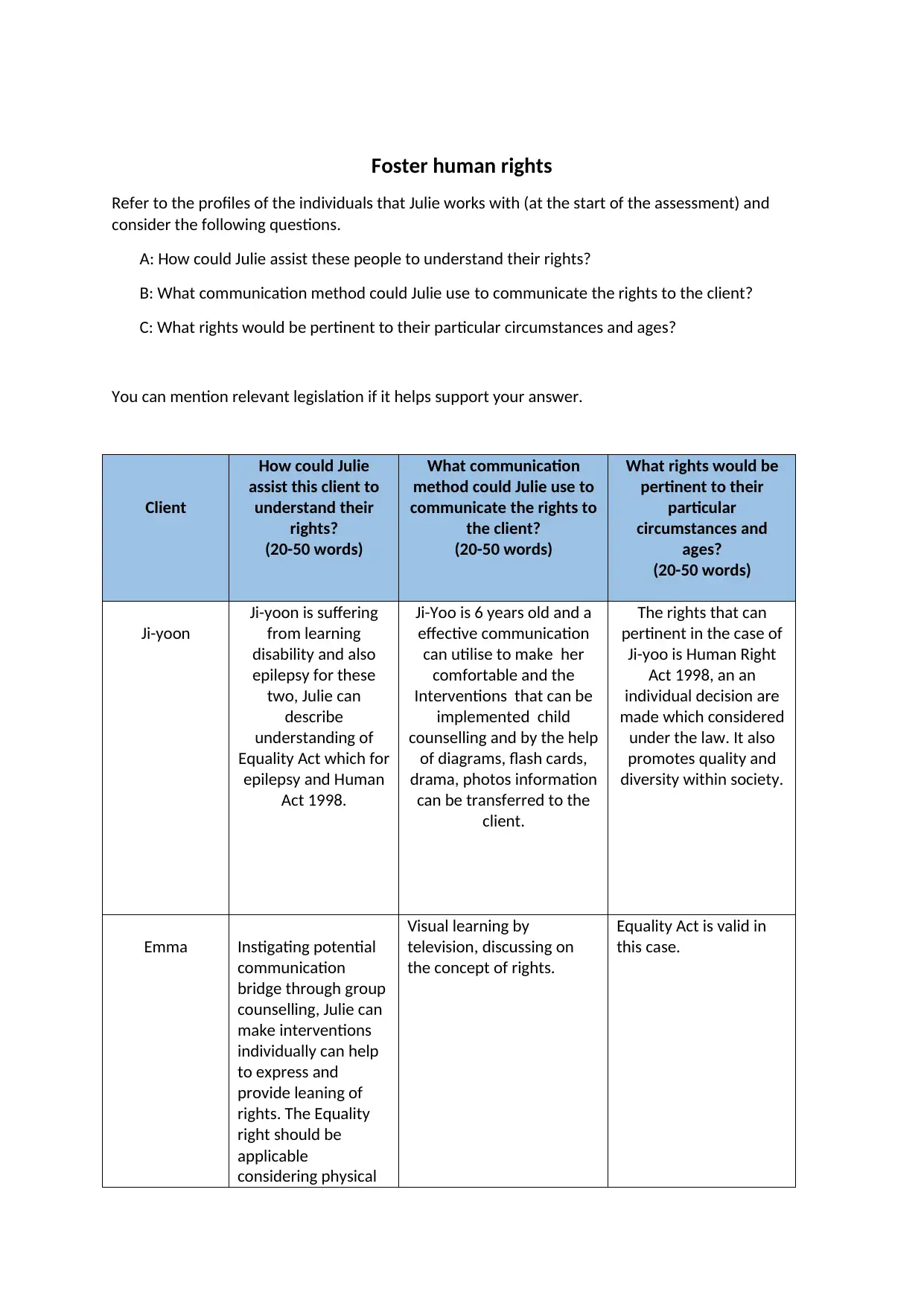
Foster human rights
Refer to the profiles of the individuals that Julie works with (at the start of the assessment) and
consider the following questions.
A: How could Julie assist these people to understand their rights?
B: What communication method could Julie use to communicate the rights to the client?
C: What rights would be pertinent to their particular circumstances and ages?
You can mention relevant legislation if it helps support your answer.
Client
How could Julie
assist this client to
understand their
rights?
(20-50 words)
What communication
method could Julie use to
communicate the rights to
the client?
(20-50 words)
What rights would be
pertinent to their
particular
circumstances and
ages?
(20-50 words)
Ji-yoon
Ji-yoon is suffering
from learning
disability and also
epilepsy for these
two, Julie can
describe
understanding of
Equality Act which for
epilepsy and Human
Act 1998.
Ji-Yoo is 6 years old and a
effective communication
can utilise to make her
comfortable and the
Interventions that can be
implemented child
counselling and by the help
of diagrams, flash cards,
drama, photos information
can be transferred to the
client.
The rights that can
pertinent in the case of
Ji-yoo is Human Right
Act 1998, an an
individual decision are
made which considered
under the law. It also
promotes quality and
diversity within society.
Emma Instigating potential
communication
bridge through group
counselling, Julie can
make interventions
individually can help
to express and
provide leaning of
rights. The Equality
right should be
applicable
considering physical
Visual learning by
television, discussing on
the concept of rights.
Equality Act is valid in
this case.
Refer to the profiles of the individuals that Julie works with (at the start of the assessment) and
consider the following questions.
A: How could Julie assist these people to understand their rights?
B: What communication method could Julie use to communicate the rights to the client?
C: What rights would be pertinent to their particular circumstances and ages?
You can mention relevant legislation if it helps support your answer.
Client
How could Julie
assist this client to
understand their
rights?
(20-50 words)
What communication
method could Julie use to
communicate the rights to
the client?
(20-50 words)
What rights would be
pertinent to their
particular
circumstances and
ages?
(20-50 words)
Ji-yoon
Ji-yoon is suffering
from learning
disability and also
epilepsy for these
two, Julie can
describe
understanding of
Equality Act which for
epilepsy and Human
Act 1998.
Ji-Yoo is 6 years old and a
effective communication
can utilise to make her
comfortable and the
Interventions that can be
implemented child
counselling and by the help
of diagrams, flash cards,
drama, photos information
can be transferred to the
client.
The rights that can
pertinent in the case of
Ji-yoo is Human Right
Act 1998, an an
individual decision are
made which considered
under the law. It also
promotes quality and
diversity within society.
Emma Instigating potential
communication
bridge through group
counselling, Julie can
make interventions
individually can help
to express and
provide leaning of
rights. The Equality
right should be
applicable
considering physical
Visual learning by
television, discussing on
the concept of rights.
Equality Act is valid in
this case.
⊘ This is a preview!⊘
Do you want full access?
Subscribe today to unlock all pages.

Trusted by 1+ million students worldwide
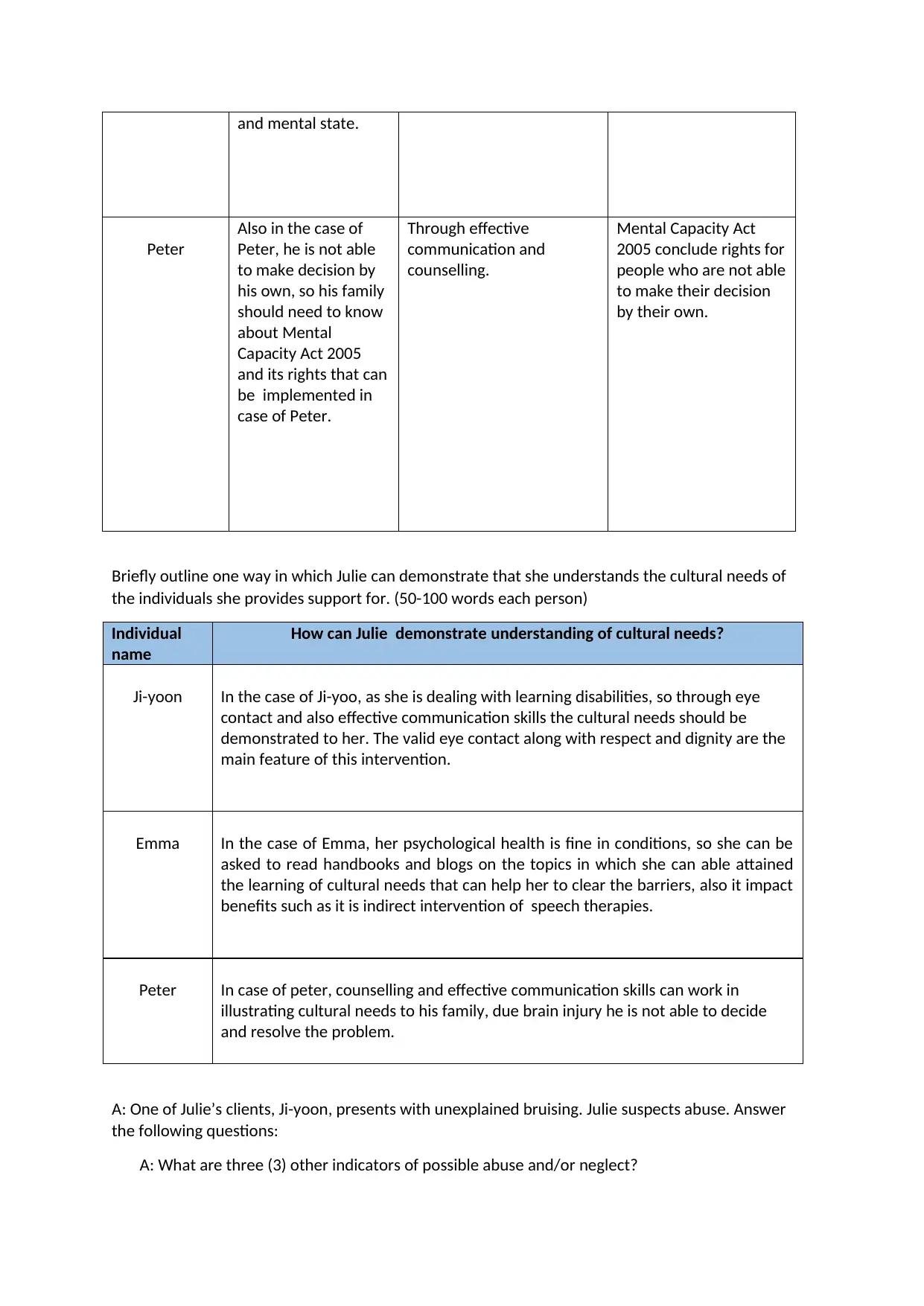
and mental state.
Peter
Also in the case of
Peter, he is not able
to make decision by
his own, so his family
should need to know
about Mental
Capacity Act 2005
and its rights that can
be implemented in
case of Peter.
Through effective
communication and
counselling.
Mental Capacity Act
2005 conclude rights for
people who are not able
to make their decision
by their own.
Briefly outline one way in which Julie can demonstrate that she understands the cultural needs of
the individuals she provides support for. (50-100 words each person)
Individual
name
How can Julie demonstrate understanding of cultural needs?
Ji-yoon In the case of Ji-yoo, as she is dealing with learning disabilities, so through eye
contact and also effective communication skills the cultural needs should be
demonstrated to her. The valid eye contact along with respect and dignity are the
main feature of this intervention.
Emma In the case of Emma, her psychological health is fine in conditions, so she can be
asked to read handbooks and blogs on the topics in which she can able attained
the learning of cultural needs that can help her to clear the barriers, also it impact
benefits such as it is indirect intervention of speech therapies.
Peter In case of peter, counselling and effective communication skills can work in
illustrating cultural needs to his family, due brain injury he is not able to decide
and resolve the problem.
A: One of Julie’s clients, Ji-yoon, presents with unexplained bruising. Julie suspects abuse. Answer
the following questions:
A: What are three (3) other indicators of possible abuse and/or neglect?
Peter
Also in the case of
Peter, he is not able
to make decision by
his own, so his family
should need to know
about Mental
Capacity Act 2005
and its rights that can
be implemented in
case of Peter.
Through effective
communication and
counselling.
Mental Capacity Act
2005 conclude rights for
people who are not able
to make their decision
by their own.
Briefly outline one way in which Julie can demonstrate that she understands the cultural needs of
the individuals she provides support for. (50-100 words each person)
Individual
name
How can Julie demonstrate understanding of cultural needs?
Ji-yoon In the case of Ji-yoo, as she is dealing with learning disabilities, so through eye
contact and also effective communication skills the cultural needs should be
demonstrated to her. The valid eye contact along with respect and dignity are the
main feature of this intervention.
Emma In the case of Emma, her psychological health is fine in conditions, so she can be
asked to read handbooks and blogs on the topics in which she can able attained
the learning of cultural needs that can help her to clear the barriers, also it impact
benefits such as it is indirect intervention of speech therapies.
Peter In case of peter, counselling and effective communication skills can work in
illustrating cultural needs to his family, due brain injury he is not able to decide
and resolve the problem.
A: One of Julie’s clients, Ji-yoon, presents with unexplained bruising. Julie suspects abuse. Answer
the following questions:
A: What are three (3) other indicators of possible abuse and/or neglect?
Paraphrase This Document
Need a fresh take? Get an instant paraphrase of this document with our AI Paraphraser
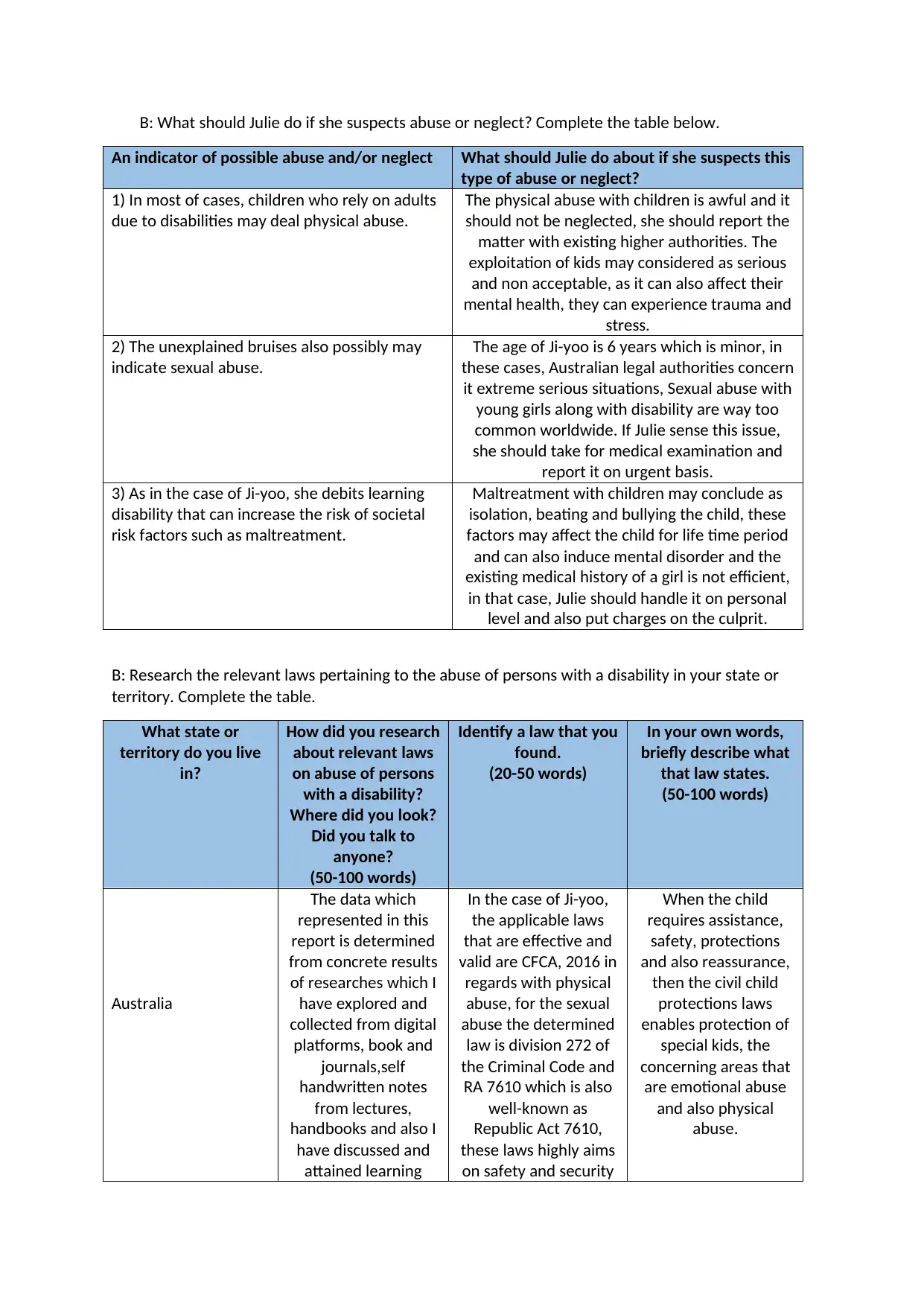
B: What should Julie do if she suspects abuse or neglect? Complete the table below.
An indicator of possible abuse and/or neglect What should Julie do about if she suspects this
type of abuse or neglect?
1) In most of cases, children who rely on adults
due to disabilities may deal physical abuse.
The physical abuse with children is awful and it
should not be neglected, she should report the
matter with existing higher authorities. The
exploitation of kids may considered as serious
and non acceptable, as it can also affect their
mental health, they can experience trauma and
stress.
2) The unexplained bruises also possibly may
indicate sexual abuse.
The age of Ji-yoo is 6 years which is minor, in
these cases, Australian legal authorities concern
it extreme serious situations, Sexual abuse with
young girls along with disability are way too
common worldwide. If Julie sense this issue,
she should take for medical examination and
report it on urgent basis.
3) As in the case of Ji-yoo, she debits learning
disability that can increase the risk of societal
risk factors such as maltreatment.
Maltreatment with children may conclude as
isolation, beating and bullying the child, these
factors may affect the child for life time period
and can also induce mental disorder and the
existing medical history of a girl is not efficient,
in that case, Julie should handle it on personal
level and also put charges on the culprit.
B: Research the relevant laws pertaining to the abuse of persons with a disability in your state or
territory. Complete the table.
What state or
territory do you live
in?
How did you research
about relevant laws
on abuse of persons
with a disability?
Where did you look?
Did you talk to
anyone?
(50-100 words)
Identify a law that you
found.
(20-50 words)
In your own words,
briefly describe what
that law states.
(50-100 words)
Australia
The data which
represented in this
report is determined
from concrete results
of researches which I
have explored and
collected from digital
platforms, book and
journals,self
handwritten notes
from lectures,
handbooks and also I
have discussed and
attained learning
In the case of Ji-yoo,
the applicable laws
that are effective and
valid are CFCA, 2016 in
regards with physical
abuse, for the sexual
abuse the determined
law is division 272 of
the Criminal Code and
RA 7610 which is also
well-known as
Republic Act 7610,
these laws highly aims
on safety and security
When the child
requires assistance,
safety, protections
and also reassurance,
then the civil child
protections laws
enables protection of
special kids, the
concerning areas that
are emotional abuse
and also physical
abuse.
An indicator of possible abuse and/or neglect What should Julie do about if she suspects this
type of abuse or neglect?
1) In most of cases, children who rely on adults
due to disabilities may deal physical abuse.
The physical abuse with children is awful and it
should not be neglected, she should report the
matter with existing higher authorities. The
exploitation of kids may considered as serious
and non acceptable, as it can also affect their
mental health, they can experience trauma and
stress.
2) The unexplained bruises also possibly may
indicate sexual abuse.
The age of Ji-yoo is 6 years which is minor, in
these cases, Australian legal authorities concern
it extreme serious situations, Sexual abuse with
young girls along with disability are way too
common worldwide. If Julie sense this issue,
she should take for medical examination and
report it on urgent basis.
3) As in the case of Ji-yoo, she debits learning
disability that can increase the risk of societal
risk factors such as maltreatment.
Maltreatment with children may conclude as
isolation, beating and bullying the child, these
factors may affect the child for life time period
and can also induce mental disorder and the
existing medical history of a girl is not efficient,
in that case, Julie should handle it on personal
level and also put charges on the culprit.
B: Research the relevant laws pertaining to the abuse of persons with a disability in your state or
territory. Complete the table.
What state or
territory do you live
in?
How did you research
about relevant laws
on abuse of persons
with a disability?
Where did you look?
Did you talk to
anyone?
(50-100 words)
Identify a law that you
found.
(20-50 words)
In your own words,
briefly describe what
that law states.
(50-100 words)
Australia
The data which
represented in this
report is determined
from concrete results
of researches which I
have explored and
collected from digital
platforms, book and
journals,self
handwritten notes
from lectures,
handbooks and also I
have discussed and
attained learning
In the case of Ji-yoo,
the applicable laws
that are effective and
valid are CFCA, 2016 in
regards with physical
abuse, for the sexual
abuse the determined
law is division 272 of
the Criminal Code and
RA 7610 which is also
well-known as
Republic Act 7610,
these laws highly aims
on safety and security
When the child
requires assistance,
safety, protections
and also reassurance,
then the civil child
protections laws
enables protection of
special kids, the
concerning areas that
are emotional abuse
and also physical
abuse.
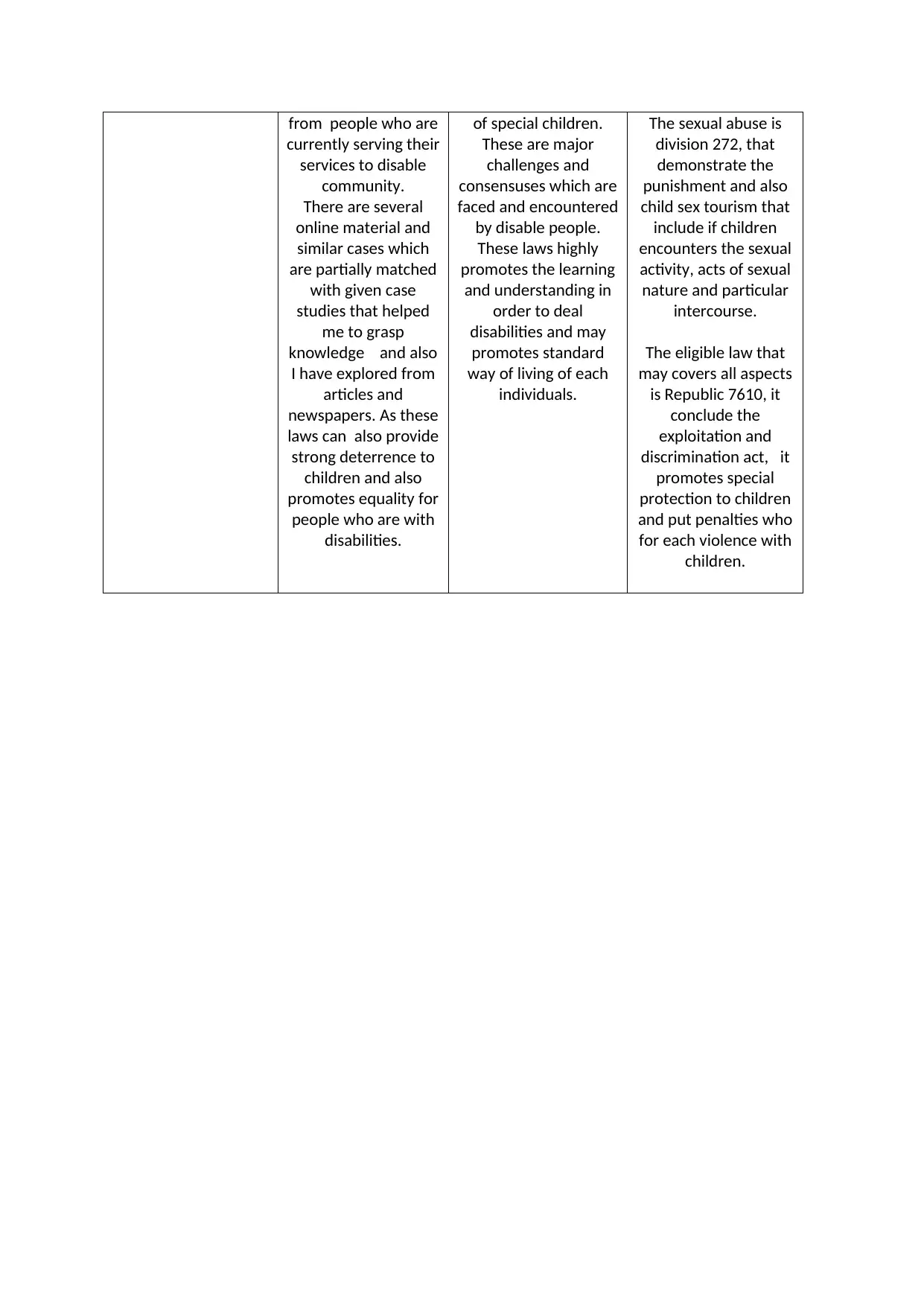
from people who are
currently serving their
services to disable
community.
There are several
online material and
similar cases which
are partially matched
with given case
studies that helped
me to grasp
knowledge and also
I have explored from
articles and
newspapers. As these
laws can also provide
strong deterrence to
children and also
promotes equality for
people who are with
disabilities.
of special children.
These are major
challenges and
consensuses which are
faced and encountered
by disable people.
These laws highly
promotes the learning
and understanding in
order to deal
disabilities and may
promotes standard
way of living of each
individuals.
The sexual abuse is
division 272, that
demonstrate the
punishment and also
child sex tourism that
include if children
encounters the sexual
activity, acts of sexual
nature and particular
intercourse.
The eligible law that
may covers all aspects
is Republic 7610, it
conclude the
exploitation and
discrimination act, it
promotes special
protection to children
and put penalties who
for each violence with
children.
currently serving their
services to disable
community.
There are several
online material and
similar cases which
are partially matched
with given case
studies that helped
me to grasp
knowledge and also
I have explored from
articles and
newspapers. As these
laws can also provide
strong deterrence to
children and also
promotes equality for
people who are with
disabilities.
of special children.
These are major
challenges and
consensuses which are
faced and encountered
by disable people.
These laws highly
promotes the learning
and understanding in
order to deal
disabilities and may
promotes standard
way of living of each
individuals.
The sexual abuse is
division 272, that
demonstrate the
punishment and also
child sex tourism that
include if children
encounters the sexual
activity, acts of sexual
nature and particular
intercourse.
The eligible law that
may covers all aspects
is Republic 7610, it
conclude the
exploitation and
discrimination act, it
promotes special
protection to children
and put penalties who
for each violence with
children.
⊘ This is a preview!⊘
Do you want full access?
Subscribe today to unlock all pages.

Trusted by 1+ million students worldwide
1 out of 6
Related Documents
Your All-in-One AI-Powered Toolkit for Academic Success.
+13062052269
info@desklib.com
Available 24*7 on WhatsApp / Email
![[object Object]](/_next/static/media/star-bottom.7253800d.svg)
Unlock your academic potential
Copyright © 2020–2025 A2Z Services. All Rights Reserved. Developed and managed by ZUCOL.





